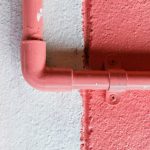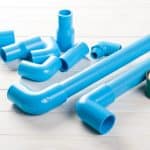PVC and uPVC pipes seem like they would be almost the same thing, but are they different? Do they come in the same colors and sizes?
PVC and uPVC pipes typically come in different colors and sizes. PVC pipes are usually white and come in typical pipe sizes. uPVC is more rigid and is used for other purposes, so it usually comes in various sizes. uPVC piping is typically cream-colored but can be gray or black as well.
Now that we can see the difference between these two types of pipes, it is important to understand what they are, what their purposes are, and truly understand the difference between PVC and uPVC. So, keep reading to learn more!

What Is PVC/uPVC?
PVC stands for polyvinyl chloride and uPVC stands for unplasticized polyvinyl chloride.
Both of these types of materials have a lot in common chemically, but they have one big and important distinction. PVC is more flexible than uPVC.
This flexibility makes PVC preferred to do certain jobs that uPVC is not formulated to do well. Most people do not notice a difference between the two, calling both of them PVC.
PVC (Polyvinyl Chloride)
PVC is typically white, low cost, and easy to install. It is the most well-known type of piping. Some of the uses of PVC are as replacement pipes, many aspects of home construction, and even as insulation for wiring and cables.
PVC is preferred in comparison to other forms of plastic or metal because it is generally user-friendly and easy to make.
Plumbers and other tradesmen appreciate and use PVC often because it is easier to maintain, repair, and get parts for.
Instead of having to deal with getting specific metal pieces for copper and other metal parts and tubing, which can be costly and time-consuming, they can stop by a local hardware store and get the right cut of PVC for the repair.
PVC is also cheaper, often around ten dollars.
PVC is made in such a way that it could be considered sustainable because it is not dependent on using crude oil or natural gases.
You can make it in other ways that are renewable. It also is resistant to cracking under stress and lasts long periods of time with little to no maintenance.

Sometimes PVC is also used in other materials, such as medical equipment. Some other things that contain PVC are shoes, toys, some car parts, and shower curtains.
uPVC (Unplasticized Polyvinyl Chloride)
uPVC is similar to PVC in a lot of ways but has some pretty drastic differences.
- One of the big differences is the purposes that uPVC is used for. It can be used for a lot of the same things such as piping in water systems. However, because it is more rigid than PVC, it is not the main thing it is used for piping.
uPVC is typically used for construction, such as in vinyl for decks, windows, railings, and sidings.
It is built in such a way that it requires little maintenance. It is weather and decomposition-resistant, while PVC is more vulnerable to outdoor experiences.
uPVC is known to be more effective at insulating than aluminum or wood, is unaffected by bugs, and even can cancel noise.
uPVC also is known for having fewer potential health problems than PVC, so it makes it more effective in the medical field. It can be found in things like dentures and other dental pieces.
Another thing about uPVC is that it isn’t always in the shape of a pipe.
With some of the other uses, it comes in different shapes, sizes, and colors. Siding and other types of vinyl need to come in square shapes and can come in a variety of colors. That is how you end up with different colored homes and windows!
Benefits and Risks of Using PVC/uPVC

Now that we understand the basics of PVC and uPVC pipes/materials, we now need to be able to decide whether we want to use them in our projects.
PVC and uPVC are both common and easy to use. They both are helpful in construction, resistant to damage, and can be versatile in purpose and ability.
There are some things to be aware of.
PVC and uPVC both have high levels of chlorine, even as high as 57%. This means that through the production process or when it is disposed of, it can produce toxins.
These toxins have been thought to be connected to different health concerns.
However, other sources disagree with this. They argue that PVC is recyclable and can be reused over and over again easily, which makes it better for the environment than other plastics and materials.
One of the other concerns with PVC is that it is not suitable to carry drinking water.
uPVC is safe for drinking water. There is another type of plastic that is thought to be better for this called CPVC or Chlorinated Polyvinyl Chloride.
It has chlorine in the resin, or plastic covering on the pipe. It also has some other materials as well in the plastic that help this plastic be effective at different jobs. Specifically, the higher chlorine content makes it safe for transporting drinking water.
CPVC is preferred because it has the ability to handle a larger temperature range and is more resistant to corrosion than other types of PVC pipe.
You can tell a PVC pipe is a CPVC pipe because it is cream-colored while PVC is typically white.
It is important to understand the difference because they both need to be handled differently and separately. PVC and CPVC require different types of solvents and cement to function, so don’t treat them as if they were the same.
Those are the main things you need to know before you go out for your next PVC project. You are equipped to handle the basics of PVC! Good luck with your handyman experiences.





